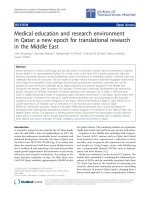a research agenda for dsm-v
Bạn đang xem bản rút gọn của tài liệu. Xem và tải ngay bản đầy đủ của tài liệu tại đây (1.91 MB, 332 trang )
A
Research
Agenda
for
DSM-V
Published by the
American Psychiatric Association
Washington, D.C.
A
Research
Agenda
for
DSM-V
Edited by
David J. Kupfer, M.D.
Michael B. First, M.D.
Darrel A. Regier, M.D., M.P.H.
Note: The authors have worked to ensure that all information in this book is accu-
rate at the time of publication and consistent with general psychiatric and medical
standards, and that information concerning drug dosages, schedules, and routes of
administration is accurate as of the time of publication and consistent with stan-
dards set by the U.S. Food and Drug Administration and the general medical com-
munity. As medical research and practice continue to advance, however,
therapeutic standards may change. Moreover, specific situations may require a spe-
cific therapeutic response not included in this book. For these reasons and because
human and mechanical errors sometimes occur, we recommend that readers follow
the advice of physicians directly involved in their care or the care of a member of
their family.
The findings, opinions, and conclusions of this report do not necessarily represent
the views of the officers, trustees, or all members of the American Psychiatric Asso-
ciation. The views expressed are those of the authors of the individual chapters.
Typeset in Adobe's Janson Text and Frutiger
Copyright ã 2002 American Psychiatric Association
ALL RIGHTS RESERVED
Manufactured in the United States of America on acid-free paper
06 05 04 03 02 5 4 3 2 1
First Edition
American Psychiatric Association
1400 K Street, N.W., Washington, DC 20005
www.psych.org
Library of Congress Cataloging-in-Publication Data
A research agenda for DSM-V / edited by David J. Kupfer, Michael B. First, Darrel
A. Regier.— 1st ed.
p. ; cm.
Includes bibliographical references and index.
ISBN 0-89042-292-3 (alk. paper)
1. Diagnostic and statistical manual of mental disorders. 2. Mental illness—
Diagnosis.
3. Mental illness—Classification. I. Kupfer, David J., 1941- II. First, Michael B.,
1956- III. Regier, Darrel A. IV. Dagnostic and statistical manual of mental disor-
ders.
[DNLM: 1. Mental Disorders—diagnosis. 2. Research. WM 141 R432 2002]
RC455.2.C4 R463 2002
616.89¢075—dc21
2002021556
British Library Cataloguing in Publication Data
A CIP record is available from the British Library.
Contents
Contributors . . . . . . . . . . . . . . . . . . . . . . . . . .vii
Acknowledgments . . . . . . . . . . . . . . . . . . . . xiii
Introduction . . . . . . . . . . . . . . . . . . . . . . . . . . xv
David J. Kupfer, M.D., Michael B. First, M.D.,
Darrel E. Regier, M.D., M.P.H.
1 Basic Nomenclature Issues for DSM-V . . . . . . 1
Bruce J. Rounsaville, M.D., Renato D. Alarcón, M.D., M.P.H.,
Gavin Andrews, M.D., James S. Jackson, Ph.D.,
Robert E. Kendell, M.D., Kenneth Kendler, M.D.
2 Neuroscience Research Agenda
to Guide Development of a
Pathophysiologically Based
Classification System . . . . . . . . . . . . . . . . . . . 31
Dennis S. Charney, M.D., David H. Barlow, Ph.D.,
Kelly Botteron, M.D., Jonathan D. Cohen, M.D.,
David Goldman, M.D., Raquel E. Gur, M.D., Ph.D.,
Keh-Ming Lin, M.D., M.P.H., Juan F. López, M.D.,
James H. Meador-Woodruff, M.D., Steven O. Moldin, Ph.D.,
Eric J. Nestler, M.D., Ph.D., Stanley J. Watson, M.D., Ph.D.,
Steven J. Zalcman, M.D.
3 Advances in Developmental
Science and DSM-V . . . . . . . . . . . . . . . . . . . . . 85
Daniel S. Pine, M.D., Margarita Alegria, Ph.D.,
Edwin H. Cook Jr., M.D., E. Jane Costello, Ph.D.,
Ronald E. Dahl, M.D., Doreen Koretz, Ph.D.,
Kathleen R. Merikangas, Ph.D., Allan L. Reiss, M.D.,
Benedetto Vitiello, M.D.
4 Personality Disorders and Relational
Disorders: A Research Agenda for
Addressing Crucial Gaps in DSM . . . . . . . . . 123
Michael B. First, M.D., Carl C. Bell, M.D.,
Bruce Cuthbert, Ph.D., John H Krystal, M.D.,
Robert Malison, M.D., David R. Offord, M.D.,
David Reiss, M.D., M. Tracie Shea, Ph.D.,
Tom Widiger, Ph.D., Katherine L. Wisner, M.D., M.S.
5 Mental Disorders and Disability:
Time to Reevaluate the Relationship? . . . .201
Anthony F. Lehman, M.D., M.S.P.H.,
George S. Alexopoulos, M.D., Howard Goldman, M.D., Ph.D.,
Dilip Jeste, M.D., Bedirhan Üstün, M.D.
6 Beyond the Funhouse Mirrors:
Research Agenda on Culture and
Psychiatric Diagnosis . . . . . . . . . . . . . . . . . . 219
Renato D. Alarcón, M.D., M.P.H., Margarita Alegria, Ph.D.,
Carl C. Bell, M.D., Cheryl Boyce, Ph.D., Laurence J. Kirmayer,
M.D., Keh-Ming Lin, M.D., M.P.H., Steven Lopez, Ph.D.,
Bedirhan Üstün, M.D., Katherine L. Wisner, M.D., M.S.
Appendix 6–1
Preliminary List of Suggested
Areas and Topics of Research in
Culture and Psychiatric Diagnosis . . . . . . . . 283
Index . . . . . . . . . . . . . . . . . . . . . . . . . . . . . . . 291
vii
Contributors
Renato D. Alarcón, M.D., M.P.H.
Professor and Vice-Chairman, Department of Psychiatry and Behavioral
Sciences, Emory University School of Medicine; Chief, Mental Health
Service Line, Atlanta Department of Veterans Affairs Medical Center, At-
lanta, Georgia
Margarita Alegria, Ph.D.
Professor of Health Services Administration; Director of the Center for
Evaluation and Sociomedical Research, University of Puerto Rico, San
Juan, Puerto Rico
George S. Alexopoulos, M.D.
Professor, Department of Psychiatry, The New York Hospital, Cornell
Medical Center, Westchester Division, White Plains, New York
Gavin Andrews, M.D.
Professor, School of Psychiatry, University of New South Wales at St. Vin-
cent’s Hospital, Anxiety Disorders Unit, Darlinghurst, New South Wales,
Australia
David H. Barlow, Ph.D.
Professor, Center for Adaptive Systems, Department of Psychology, Bos-
ton University, Boston, Massachusetts
Carl C. Bell, M.D.
President/CEO, Community Mental Health Council/Foundation, Inc.;
Professor of Psychiatry, Department of Psychiatry, School of Medicine,
and Professor of Public Health, School of Public Health, University of Il-
linois at Chicago, Chicago, Illinois
Kelly Botteron, M.D.
Assistant Professor, Department of Psychiatry, Washington University
School of Medicine, St. Louis, Missouri
Cheryl Boyce, Ph.D.
Chief, Sociocultural Processes and Health Disparities Program, Develop-
mental Psychopathology and Prevention Research Program, National In-
stitute of Mental Health, Bethesda, Maryland
viii A RESEARCH AGENDA FOR DSM-V
Dennis S. Charney, M.D.
Chief, Mood and Anxiety Disorders Research Program, National Institute
of Mental Health, Bethesda, Maryland
Jonathan D. Cohen, M.D.
Professor, Department of Psychology; Director, Center for Study of Brain,
Mind and Behavior, Princeton University, Princeton, New Jersey; Profes-
sor, Department of Psychiatry, University of Pittsburgh, Pittsburgh, Penn-
sylvania
Edwin H. Cook Jr., M.D.
Professor of Psychiatry and Pediatrics, Department of Child and Adoles-
cent Psychiatry, University of Chicago, Chicago, Illinois
E. Jane Costello, Ph.D.
Professor, Department of Psychiatry and Behavioral Sciences, Duke Uni-
versity Medical Center, Durham, North Carolina
Bruce Cuthbert, Ph.D.
Chief, Adult Psychopathology and Prevention Research Branch, Division
of Mental Disorders, Behavioral Research and AIDS, National Institute of
Mental Health, Bethesda, Maryland
Ronald E. Dahl, M.D.
Associate Professor of Psychiatry and Pediatrics, Western Psychiatric In-
stitute and Clinic, Pittsburgh, Pennsylvania
Michael B. First, M.D.
Research Psychiatrist, New York State Psychiatric Institute; Associate Pro-
fessor of Clinical Psychiatry, Columbia University College of Physicians
and Surgeons, New York, New York
David Goldman, M.D.
Chief, Laboratory of Neurogenetics, National Institute on Alcohol Abuse
and Alcoholism, Bethesda, Maryland
Howard Goldman, M.D., Ph.D.
Professor, Department of Psychiatry, University of Maryland, Baltimore,
Maryland
Raquel E. Gur, M.D., Ph.D.
Professor, Director of Neuropsychiatry, Departments of Psychiatry, Neu-
rology, and Radiology, University of Pennsylvania, Philadelphia, Pennsyl-
vania
Contributors ix
James S. Jackson, Ph.D.
Daniel Katz Distinguished University Professor of Psychology, College of
Literature, Science, and the Arts; Professor of Health Behavior and Health
Education, School of Public Health; and Director and Research Scientist,
Research Center for Group Dynamics, Institute for Social Research, Uni-
versity of Michigan, Ann Arbor, Michigan
Dilip Jeste, M.D.
Professor, University of California San Diego, Department of Veterans’
Affairs San Diego Healthcare System, San Diego, California
Robert E. Kendell, M.D.
Professor, University Department of Psychiatry, Royal Edinburgh Hospi-
tal, Edinburgh, Scotland
Kenneth Kendler, M.D.
Professor, Department of Psychiatry and Human Genetics, Medical Col-
lege of Virginia, Virginia Commonwealth University and Virginia Insti-
tute for Psychiatric and Behavioral Genetics, Richmond, Virginia
Laurence J. Kirmayer, M.D.
Professor, Department of Psychiatry, and Director, Division of Social and
Transcultural Psychiatry, McGill University, Montreal, Quebec, Canada
Doreen Koretz, Ph.D.
Associate Director for Prevention, Division of Mental Disorders, Behav-
ioral Research and AIDS, National Institute of Mental Health, Bethesda,
Maryland
John H. Krystal, M.D.
Albert E. Kent Professor and Deputy Chairman for Research, Department
of Psychiatry, Yale University School of Medicine, New Haven, and Psy-
chiatry Service, Veterans’ Administration Connecticut Health System,
West Haven, Connecticut
David J. Kupfer, M.D.
Thomas Detre Professor and Chair, Department of Psychiatry, Western
Psychiatric Institute and Clinic, University of Pittsburgh, Pittsburgh,
Pennsylvania
x A RESEARCH AGENDA FOR DSM-V
Anthony F. Lehman, M.D., M.S.P.H.
Professor and Chair, Department of Psychiatry, University of Maryland
School of Medicine, Baltimore, Maryland
Keh-Ming Lin, M.D., M.P.H.
Professor, Department of Psychiatry, School of Medicine, University of
California at Los Angeles; Director, Research Center on the Psychobiol-
ogy of Ethnicity, Harbor–University of California Los Angeles Medical
Center, Torrance, California
Juan F. López, M.D.
Assistant Professor, Department of Psychiatry, University of Michigan;
Assistant Research Scientist, Mental Health Research Institute, Ann Arbor,
Michigan
Steven Lopez, Ph.D.
Professor of Psychology and Psychiatry, Department of Psychology, Uni-
versity of California, Los Angeles, Los Angeles, California
Robert Malison, M.D.
Associate Professor of Psychiatry and Associate Director, Clinical Neuro-
science Research Unit, Connecticut Mental Health Center, Yale Univer-
sity School of Medicine, New Haven, Connecticut
James H. Meador-Woodruff, M.D.
Associate Professor, Department of Psychiatry, University of Michigan;
Senior Associate Research Scientist, Mental Health Research Institute,
Ann Arbor, Michigan
Kathleen R. Merikangas, Ph.D.
Chief, Section on Developmental Genetic Epidemiology, Mood and Anx-
iety Disorders Program, National Institute of Mental Health, Bethesda,
Maryland
Steven O. Moldin, Ph.D.
Chief, Genetics Research Branch, Division of Neuroscience and Basic Be-
havioral Science, National Institute of Mental Health, Bethesda, Maryland
Eric J. Nestler, M.D., Ph.D.
Professor and Chairman, Department of Psychiatry, University of Texas
Southwestern Medical Center, Dallas, Texas
David R. Offord, M.D.
Coordinator of Research Programs, Center for Studies of Children at Risk,
McMaster University, Hamilton, Ontario, Canada
Contributors xi
Daniel S. Pine, M.D.
Chief, Section on Development and Affective Neuroscience, National In-
stitute of Mental Health, Bethesda, Maryland
Darrel A. Regier, M.D., M.P.H.
Executive Director, American Psychiatric Institute for Research and Edu-
cation, and Director, Division of Research, American Psychiatric Associa-
tion, Washington, DC
Allan L. Reiss, M.D.
Professor and Associate Chair, Department of Psychiatry and Behavioral
Science, Stanford University School of Medicine, Stanford, California
David Reiss, M.D.
Vivian Gill Distinguished Research Professor of Psychiatry, Psychology,
and Medicine, George Washington University Medical Center, Washing-
ton, DC
Bruce J. Rounsaville, M.D.
Professor, Yale University School of Medicine; Director, Mental Illness
Research Education and Clinical Center, Department of Veterans Affairs
Connecticut Healthcare, West Haven, Connecticut
M. Tracie Shea, Ph.D.
Associate Professor, Department of Psychiatry and Human Behavior,
Brown University, Providence, Rhode Island
Bedirhan Üstün, M.D.
Coordinator, Classification, Assessment, Surveys and Terminology, EIP/
GPE, World Health Organization, Geneva, Switzerland
Benedetto Vitiello, M.D.
Chief, Child and Adolescent Treatment and Preventive Intervention Re-
search Branch, Division of Services and Intervention Research, National
Institute of Mental Health, Bethesda, Maryland
Stanley J. Watson, M.D., Ph.D.
Professor of Psychiatry, University of Michigan; Co-Director and Senior Re-
search Scientist, Mental Health Research Institute, Ann Arbor, Michigan
xii A RESEARCH AGENDA FOR DSM-V
Tom Widiger, Ph.D.
Professor, Department of Psychology, University of Kentucky, Lexington,
Kentucky
Katherine L. Wisner, M.D., M.S.
Gottfried and Gisella Kolb Professor of Outpatient Psychiatry and Behav-
ioral Sciences, Obstetrics and Gynecology, and Pediatrics, and Director,
Women’s Health Care, Department of Psychiatry, University of Louisville
School of Medicine, Louisville, Kentucky
Steven J. Zalcman, M.D.
Chief, Clinical Neuroscience Research Branch, Division of Neuroscience
and Basic Behavioral Science, National Institute of Mental Health, Be-
thesda, Maryland
xiii
Acknowledgments
We would like to acknowledge the scientific and administrative contri-
butions to this book made by the following staff of the American Psychiat-
ric Association: Natalie Ivanovs, Tina Marshall, Ph.D., William Narrow,
M.D., M.P.H., and Sarah Tracy.
xv
Introduction
This volume, made up of six “white papers” in six chapters, completes the
initial phase of a DSM-V planning process, which began in 1999. It is im-
portant to underscore that this work should not be construed as the initial
stages of the DSM-V revision process. As far as we participants in the
white-paper process are concerned, the beginning of the DSM-V revision
process is still several years in the future. These chapters are an attempt to
stimulate research and discussion in the field in preparation for the even-
tual start of the DSM-V revision process. The chapters were produced un-
der a partnership between the American Psychiatric Association (APA) and
the National Institute of Mental Health (NIMH), with the goal of provid-
ing direction and potential incentives for research that could improve the
scientific basis of future classifications. Given the relatively short time
frame for generating breakthrough research findings between now and the
probable publication of DSM-V in 2010, it is anticipated that some of the
research agendas suggested in these chapters might not bear fruit until the
DSM-VI or even DSM-VII revision processes! Nonetheless, we feel that
we cannot ignore this opportunity to identify and stimulate broad research
fields that could fundamentally alter the limited classification paradigm
now in use. Those of us who have worked for several decades to improve
the reliability of our diagnostic criteria are now searching for new ap-
proaches to an understanding of etiological and pathophysiological mech-
anisms—an understanding that can improve the validity of our diagnoses
and the consequent power of our preventive and treatment interventions.
Background
There were two primary reasons for supporting designated work groups
responsible for the development of these chapters: 1) to stimulate research
that would enrich the empirical database before the start of the DSM-V re-
vision process and 2) to devise a research and analytic agenda that would fa-
cilitate the integration of findings from research and experience in animal
studies, genetics, neuroscience, epidemiology, clinical research, and cross-
cultural clinical services—all of which would lead to the eventual develop-
ment of an etiologically based, scientifically sound classification system.
xvi A RESEARCH AGENDA FOR DSM-V
Need to Reconsider the Relationship Between the
DSM Process and the Research Database
Since DSM-III (American Psychiatric Association 1980), disorders have
been defined in terms of syndromes—that is, clusters of symptoms that co-
vary together (see the section following, titled “Need to Explore the Pos-
sibility of Fundamental Changes . . .”). The most significant innovation
adopted in DSM-IV (American Psychiatric Association 1994) was a revi-
sion process that 1) incorporated a comprehensive review of the available
empirical research findings and 2) made new analyses of existing epidemi-
ological and clinical research data sets to generate proposed diagnostic cri-
teria sets. In addition, NIMH provided limited funding for a field-study
grant to compare the reliability and utility of alternative criteria sets for di-
agnoses in clinical settings Although changes from DSM-II (American Psy-
chiatric Association 1968) to DSM-III were based on more than a decade
of clinical research using the Feighner (Feighner et al. 1972) and Research
Diagnostic Criteria (RDC) (Spitzer et al. 1978), no systematic literature re-
view or focused analysis was undertaken in the actual revision process. In-
stead, decisions on inclusion and exclusion criteria were made by
individuals who were considered experts in their fields, a process that po-
tentially allowed data to be either overlooked or, if they were at odds with
the expert’s perspective, willfully ignored. The major focus of field trials
for DSM-III was establishing the reliability with which multiple clinicians
could come to the same diagnostic conclusions when presented with a pa-
tient’s expressed signs and symptoms. In this manner, it was possible to
demonstrate that an atheoretical, descriptive approach could result in a re-
producible diagnosis in multiple clinical and cultural settings.
Following the publication of DSM-III in 1980, data began to emerge
by 1983 from some new studies that were not consistent with the syndro-
mal definitions in DSM-III. Likewise, challenges were being made to hier-
archical diagnostic conventions that precluded a diagnosis of some
disorders when a more severe disorder was simultaneously present (e.g., a
patient with symptoms meeting criteria for both schizophrenia and panic
disorder would get only the diagnosis of schizophrenia) (Boyd et al. 1984).
Overall, the major goal of DSM-III-R (American Psychiatric Association
1987) was to improve the consistency, clarity, and conceptual accuracy of
DSM-III criteria but to avoid changes lacking substantial research evi-
dence. No major data analyses or field trials to establish the reliability or
validity of these changes were conducted. DSM-IV continued with the de-
scriptive approach but added a meta-analytic, data-based approach to the
revision process, described in the paragraphs following.
The DSM-IV revision process was formalized in a three-stage em-
Introduction xvii
pirical review (Widiger et al. 1991). The first stage consisted of a sys-
tematic, comprehensive review of the published (and in some cases
unpublished) literature, guided by literature searches using rules speci-
fied during a DSM-IV methods conference. Although many gaps were
identified in the existing literature, only limited options were available
to the work groups for filling in these gaps. One such mechanism was a
data reanalysis project funded by the MacArthur Foundation, in which
existing data sets collected for other studies were combined and reana-
lyzed, using meta-analytic methods, to try to answer certain diagnostic
questions. These data reanalyses were useful in answering some diag-
nostic questions (e.g., determining the minimum number of panic at-
tacks required in order to justify a diagnosis of panic disorder [Brown et
al. 1998]); however, many of the reanalyses were seriously hampered by
incompatibilities in the data sets and by the fact that the data needed for
answering many diagnostic questions had not been collected. The only
empirical data collected specifically for the DSM-IV revision process
were those from the 15 NIMH-funded focused field trials. Because of
the limited resources available and the short time available for conduct-
ing these trials, the goals of the trials were fairly modest. In most cases,
goals were limited to comparing different criteria sets in terms of reli-
ability and user acceptability. In cases in which some form of validity
was measured, the gold standard used was conformity with a simulta-
neously assigned clinical diagnosis, as opposed to use of any of the more
rigorous Robins-Guze validity criteria (Robins and Guze 1970).
One of the main reasons that the DSM-IV process was almost com-
pletely dependent on already collected data was the extremely short dead-
line imposed on the DSM-IV process. Because of the need to coordinate
the development of DSM-IV with the parallel development of the Interna-
tional Statistical Classification of Diseases and Related Health Problems, 10th
Revision (ICD-10) by the World Health Organization (World Health Or-
ganization 1992), work began on DSM-IV within a year of the publication
of DSM-III-R in 1987. Publication of DSM-IV was also scheduled for
1994 in anticipation of worldwide adoption of ICD-10 in the mid-1990s.
(Ironically, ICD-10 has still not been officially adopted in the United
States, owing to many administrative matters related to financial and com-
puter reprogramming concerns.) Although it became evident in 1993 that
ICD-10 implementation was going to be delayed, the APA decided to pro-
ceed with the 1994 publication of DSM-IV so as not to compromise the
currency of the literature review.
As mentioned previously, publication of DSM-V is expected about
2010 (or perhaps later), thus providing the opportunity to stimulate poten-
tially informative research before the DSM-V revision process begins. Ac-
xviii A RESEARCH AGENDA FOR DSM-V
cordingly, the chapters in this volume provide a wide range of suggestions
about fruitful areas to be further investigated well in advance of DSM-V.
Need to Explore the Possibility of Fundamental Changes in
the Neo-Kraepelinian Diagnostic Paradigm
The DSM-III diagnostic system adopted a so-called neo-Kraepelinian ap-
proach to diagnosis. This approach avoided organizing a diagnostic system
around hypothetical but unproven theories about etiology in favor of a de-
scriptive approach, in which disorders were characterized in terms of
symptoms that could be elicited by patient report, direct observation, and
measurement. The major advantage of adopting a descriptive classification
was its improved reliability over prior classification systems using nonop-
erationalized definitions of disorders based on unproved etiological as-
sumptions. From the outset, however, it was recognized that the primary
strength of a descriptive approach was its ability to improve communica-
tion among clinicians and researchers, not its established validity.
Disorders in DSM-III were identified in terms of syndromes, symp-
toms that are observed in clinical populations to covary together in individ-
uals. It was presumed that, as in general medicine, the phenomenon of
symptom covariation could be explained by a common underlying etiology.
As described by Robins and Guze (1970), the validity of these identified
syndromes could be incrementally improved through increasingly precise
clinical description, laboratory studies, delimitation of disorders, follow-up
studies of outcome, and family studies. Once fully validated, these syn-
dromes would form the basis for the identification of standard, etiologically
homogeneous groups that would respond to specific treatments uniformly.
In the more than 30 years since the introduction of the Feighner crite-
ria by Robins and Guze, which eventually led to DSM-III, the goal of val-
idating these syndromes and discovering common etiologies has remained
elusive. Despite many proposed candidates, not one laboratory marker has
been found to be specific in identifying any of the DSM-defined syn-
dromes. Epidemiologic and clinical studies have shown extremely high
rates of comorbidities among the disorders, undermining the hypothesis
that the syndromes represent distinct etiologies. Furthermore, epidemio-
logic studies have shown a high degree of short-term diagnostic instability
for many disorders. With regard to treatment, lack of treatment specificity
is the rule rather than the exception.
The efficacy of many psychotropic medications cuts across the DSM-
defined categories. For example, the selective serotonin reuptake inhibitors
(SSRIs) have been demonstrated to be efficacious in a wide variety of dis-
orders, described in many different sections of DSM, including major de-
Introduction xix
pressive disorder, panic disorder, obsessive-compulsive disorder, dysthymic
disorder, bulimia nervosa, social anxiety disorder, posttraumatic stress dis-
order, generalized anxiety disorder, hypochondriasis, body dysmorphic dis-
order, and borderline personality disorder. Results of twin studies have also
contradicted the DSM assumption that separate syndromes have a different
underlying genetic basis. For example, twin studies have shown that gener-
alized anxiety disorder and major depressive disorder may share genetic
risk factors (Kendler 1996).
Concerns have also been raised that researchers’ slavish adoption of
DSM-IV definitions may have hindered research in the etiology of mental
disorders. Few question the value of having a well-described, well-opera-
tionalized, and universally accepted diagnostic system to facilitate diagnos-
tic comparisons across studies and to improve diagnostic reliability.
However, reification of DSM-IV entities, to the point that they are consid-
ered to be equivalent to diseases, is more likely to obscure than to elucidate
research findings.
All these limitations in the current diagnostic paradigm suggest that
research exclusively focused on refining the DSM-defined syndromes may
never be successful in uncovering their underlying etiologies. For that to
happen, an as yet unknown paradigm shift may need to occur. Therefore,
another important goal of this volume is to transcend the limitations of the
current DSM paradigm and to encourage a research agenda that goes be-
yond our current ways of thinking to attempt to integrate information from
a wide variety of sources and technologies.
Process of Developing This Volume
The DSM-V research planning process started with a brief discussion be-
tween Steven Hyman, M.D. (Director of NIMH), Steven M. Mirin, M.D.
(Medical Director of APA), and David J. Kupfer, M.D. (Chair of the APA
Committee on Psychiatric Diagnosis and Assessment), at NIMH in sum-
mer 1999. They felt that it was important for APA and NIMH to work to-
gether and focus on an agenda that would expand the scientific basis for
psychiatric classification.
In September 1999, the initial DSM-V Research Planning Conference
was held under the joint sponsorship of APA and NIMH. From the outset,
it was established that this was not meant to be the first step of the DSM-V
revision process per se but rather to set research priorities that might affect
future classifications. Participants in this initial stage were selected primar-
ily for their expertise in diverse areas such as family and twin studies, mo-
lecular genetics, basic and clinical neuroscience, cognitive and behavioral
xx A RESEARCH AGENDA FOR DSM-V
science, development, life span issues, and disability. To encourage think-
ing that went beyond the current DSM-IV framework, participant selec-
tion was made primarily among those who had not been closely involved in
the DSM-IV development process. The participants were given the chance
to consider new and emerging data, to identify knowledge gaps, and to sug-
gest how data might be generated to fill those gaps. Participants were cau-
tioned against thinking too narrowly with regard to how new information
from emerging fields such as neuroscience and genetics might be used in a
classification system.
A number of topics were identified as being particularly important and
in need of further research. These included examining how disorders are
manifested differently in child, adult, and geriatric age groups; identifying
risk factors for disorders to facilitate prevention; and attempting to recon-
cile the Axis I–Axis II distinction with the concept of spectrum disorders.
Broader considerations included the benefits of explicitly indicating that
the disorders included in DSM have varying levels of empirical support for
their reliability and validity. Given the addition of clear clinical significance
criteria in DSM-IV, questions arose about how severity, distress, and dis-
ability should be accounted for in the classification—either as a part of the
criteria set for threshold determinations, or as an orthogonal and separate
construct. Finally, questions arose about the potential role for information
gleaned from family studies, molecular genetics, neuroscience, cognitive
fields, and behavioral science in constructing the diagnostic nomenclature.
At the conclusion of the meeting, it was decided that this group of partici-
pants would develop a series of white papers that could promote further
discussion of these topics and guide future research.
The task of developing the chapters was delegated to DSM-V Plan-
ning Work Groups assigned to cover the following five topic areas: Devel-
opmental Issues, Gaps in the Current System, Disability and Impairment,
Neuroscience, and Nomenclature. The first step was to appoint chairs for
each of the work groups: Daniel S. Pine, M.D., for the Developmental
Work Group; Michael B. First, M.D., for the Gaps Work Group; Anthony
Lehman, M.D., for the Disability and Impairment Work Group; Dennis S.
Charney, M.D., for the Neuroscience Work Group; and Bruce J. Roun-
saville, M.D., for the Nomenclature Work Group.
A second DSM-V Research Planning Conference was held on July 25,
2000, involving only the chairs of the work groups. The purpose was to dis-
cuss the membership of the work groups, consider the process that would
guide the groups as they developed the chapters, develop a timeline, and
discuss how the issues raised in the white papers might be integrated into a
research agenda. Each work group was composed of 4–10 people with dif-
ferent areas of expertise. Some work group members included those who
Introduction xxi
participated in the September 1999 meeting; others were invited because
of their expertise in different fields. In the interests of developing a com-
mon international classification in the future, a number of members of the
international research community were invited to participate. Liaisons
from NIMH, the National Institute on Drug Abuse (NIDA), and the Na-
tional Institute on Alcohol Abuse and Alcoholism (NIAAA) were assigned
to each work group to facilitate the integration of the white papers into the
research programs or requests for applications (RFAs) in these institutes. It
was suggested that some of these white papers might lead to joint work-
shops sponsored by the three institutes.
A third DSM-V Research Planning Conference, held October 5–6,
2000, brought together all the work group members to allow each work
group to begin its work on the white papers, to present initial outlines to
the entire set of participants, and to elicit input reflecting perspectives from
individuals outside the work groups. During the ensuing discussions, it was
emphasized that the goals of improving future editions of DSM and defin-
ing a research agenda must be uncoupled and that all work groups must
consider their objectives from both a short-term and a long-term perspec-
tive (i.e., must take into consideration that a proposed research agenda
might not have any effect on classification until DSM-VI or later).
In addition to the five work groups mentioned previously, a cross-cul-
tural work group was also formed, chaired by Renato D. Alarcón, M.D.
Each of the other five work groups had at least one cross-cultural work
group member assigned to it to provide expertise on how cross-cultural is-
sues might pertain to the topic covered by the work group. Concurrently
with their work in the original work group, the cross-cultural work group
members also convened as a separate entity to review cross-cultural issues
in psychopathology in a more comprehensive fashion and to produce a
chapter integrating those issues across the whole range of research areas.
Subsequent to this meeting, the work groups met regularly through
conference calls. All the work groups followed a similar model: developing
an outline, assigning sections to individual members, integrating the indi-
vidual sections into a single draft, and then circulating the draft to the full
work group for additional input. Work groups were also encouraged to so-
licit comments from consultants outside the work groups. Finally, drafts of
the white papers were circulated to outside reviewers for their comments
and suggestions.
Future Steps
Following completion of this volume, it is anticipated that a series of diag-
nostic conferences will be convened to encourage more focused research
xxii A RESEARCH AGENDA FOR DSM-V
investigations from the entire range of research areas covered in the chap-
ters. For example, a conference focused on mood disorders, scheduled to
take place at the World Congress of Psychiatry in August 2002, will present
pertinent findings from preclinical animal models, genetics, pathophysiol-
ogy, functional imaging, clinical treatment, epidemiology, prevention, the
relationship with other cardiovascular medical conditions, and the global
burden of disability associated with the spectrum of depressive disorders.
By presenting different perspectives such as these on specific disorders, our
plan is to maximize the potential for cross-fertilization of multiple research
disciplines, which will stimulate new and creative approaches to integrating
their findings. A more precise algorithm for weighing the contributions
from these multiple research areas for the development of new diagnostic
criteria is now only a future goal, well beyond our grasp.
By engaging an international group of research investigators in each of
the proposed future diagnostic conferences, we hope to stimulate a coop-
erative research effort that can be supported by multiple national sources
of research funding. Likewise, by paying greater attention to the potential
contribution of diverse research disciplines to clinical disease and disorder
entities, and by developing alternative research criteria for some disorders
that are not constrained by the requirements of the neo-Kraepelinian cat-
egorical approach currently adopted in DSM-IV, we hope to accelerate the
development of a research base that will be maximally informative for fu-
ture revisions of the DSM and ICD classification systems for mental disor-
ders.
The authors and editors hope that our readers will find this volume re-
flective of the great potential for improving the basic understanding of
mental and addictive disorders in human populations, as well as for using
this knowledge to improve the effectiveness of preventive and treatment
interventions for our patients, our families, and our communities.
David J. Kupfer, M.D.
Michael B. First, M.D.
Darrel E. Regier, M.D., M.P.H.
References
American Psychiatric Association: Diagnostic and Statistical Manual of Mental
Disorders, 2nd Edition. Washington, DC, American Psychiatric Association,
1968
American Psychiatric Association: Diagnostic and Statistical Manual of Mental
Disorders, 3rd Edition. Washington, DC, American Psychiatric Association,
1980
Introduction xxiii
American Psychiatric Association: Diagnostic and Statistical Manual of Mental
Disorders, 3rd Edition, Revised. Washington, DC, American Psychiatric As-
sociation, 1987
American Psychiatric Association: Diagnostic and Statistical Manual of Mental
Disorders, 4th Edition. Washington, DC, American Psychiatric Association,
1994
Boyd JH, Burke JD Jr, Gruenberg E, et al: Exclusion criteria of DSM-III: a study
of co-occurrence of hierarchy-free syndromes. Arch Gen Psychiatry 41:983–
989, 1984
Brown TA, Marten PA, Barlow DH: Empirical evaluation of the panic symptom
ratings in DSM-III-R panic disorder, in DSM-IV Sourcebook, Vol 4. Edited
by Widiger TA, Frances AJ, Pincus HA, et al. Washington, DC, American Psy-
chiatric Association, 1998, pp 209–215
Feighner JF, Robins E, Guze SB, et al: Diagnostic criteria for use in psychiatric re-
search. Arch Gen Psychiatry 26:57–63, 1972
Kendler KS: Major depression and generalised anxiety disorder: same genes,
(partly) different environments—revisited. Br J Psychiatry 168(suppl 30):68–
75, 1996
Robins E, Guze SB: Establishment of diagnostic validity in psychiatric illness: its
application to schizophrenia. Am J Psychiatry 126:983–987, 1970
Spitzer RL, Endicott J, Robins E: Research diagnostic criteria: rationale and reli-
ability. Arch Gen Psychiatry 35:773–782, 1978
Widiger TA, Frances AJ, Pincus HA, et al: Toward an empirical classification for
the DSM-IV. Abnorm Psychol 100(3):280–288, 1991
World Health Organization: International Statistical Classification of Diseases and
Related Health Problems, 10th Revision. Geneva, World Health Organiza-
tion, 1992
1
CHAPTER 1
Basic Nomenclature
Issues for DSM-V
Bruce J. Rounsaville, M.D., Renato D. Alarcón, M.D., M.P.H.,
Gavin Andrews, M.D., James S. Jackson, Ph.D.,
Robert E. Kendell, M.D., Kenneth Kendler, M.D.
Introduction
The criteria and format used in DSM-III, DSM-III-R, DSM-IV, and
DSM-IV-TR (American Psychiatric Association 1980, 1987, 1994, 2000a)
arose from psychiatric diagnostic traditions of North America and were
crafted to be readily used by practicing psychiatrists. However, the effect
of the DSMs has extended far beyond the boundaries of psychiatric prac-
tice in North America in a number of ways that have revealed limitations
in the current system.
First, the American criteria are used in research and practice through-
out the world, highlighting incompatibilities with the alternative diagnos-
tic system of the International Statistical Classification of Diseases and Related
Health Problems, 10th Revision (ICD-10) (World Health Organization
1992) and difficulties in applying DSM criteria across cultures.
Second, primary care medical practitioners have increasingly taken on
the identification and initial treatment of patients with mental disorders.
This laudable development promises to bring treatment to many patients
whose conditions have been undiagnosed and untreated. However, the
need to operationalize the diagnostic process in nonpsychiatric settings has
posed important challenges to practitioners.
Third, criteria listed in the DSMs have been uncritically used by legal
professionals and health care administrators as representing lapidary, re-
ceived wisdom about the nature of mental disorders. This high-impact but
uncritical use fails to recognize the variability in the level of empirical sup-
port for the reliability and validity of different diagnoses. If the text or cri-









